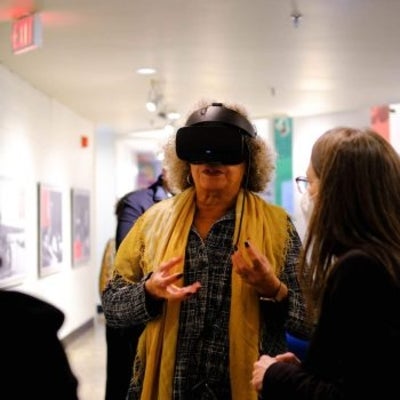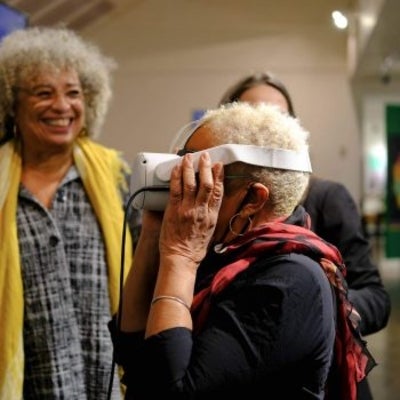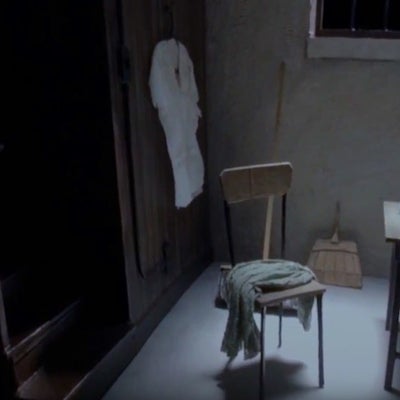
Virtual Reality for Social Justice with Dr. Kristina Llewellyn
GI Faculty member Dr. Kristina Llewellyn (Social Development Studies) is the perfect example of a scholar who fits in naturally at the Games Institute (GI), despite being a self-professed “non-gamer” in her personal life. It took GI Executive Director, Dr. Neil Randall (English Language and Literature), some time to convince Kristina to join the GI, simply because she didn’t think she was familiar enough with games-specific research. However, Kristina quickly found that there was more to the GI, and games, than what she had previously thought.
Over time, Kristina discovered that the GI was more about using interactive and immersive technologies to “address research or community-driven problems, and not so much about ‘games’ themselves per se.” Kristina had seen digital and non-digital games used to both “great positive and negative effect” in the classroom and wanted to create an educational virtual reality (VR) experience “for a social justice-oriented project.” This is when “Digital Oral Histories for Reconciliation: The Nova Scotia Home for Coloured Children History Education Initiative” (DOHR) was conceived.
DOHR is a community-based partnership that supports education via a curriculum created to educate students about the harms of the Nova Scotia Home for Coloured Children (NSHCC). The NSHCC was a segregated institution for African Nova Scotian children that opened in 1921 and closed over 70 years later. Child residents of the Home were subjected to abuse and neglect.Residents voiced the harms they experienced for decades. These harms were finally addressed in a substantial way with the NS Restorative Inquiry. With the Inquiry, the government of NS acknowledged the harms of the NSHCC and addressed how systemic racism continues to impact the lives of African Nova Scotians.
The harms survivors had faced were not addressed until the publication of the Restorative Inquiry, in which the government of Nova Scotia acknowledged the harms of NSHCC and how systemic and institutionalized racism continue to impact the lives of African Nova Scotians.
The VR portion of the DOHR curriculum features the stories of three former residents of the NSHCC, Gerry Morrison, Tony Smith, and Tracy Dorrington-Skinner who recount their experiences from within the virtually constructed learning environment. These former residents are “vocal leaders of the community” as heads of the advocacy organization Victims of Institutional Child Exploitation Society (VOICES) a critical driver of the Restorative Inquiry. The DOHR curriculum uses a restorative justice framework to share survivors’ oral histories through a VR experience that allows students to move through a digital representation of the NSHCC while listening to survivors recount what happened within its walls.
How did DOHR begin?
The origins of DOHR are not typical for an academic project; Kristina’s 11-year-old nephew, Owen, interviewed Tony Smith – one of the former residents of the NSHCC – for a school project. Tony thought that Owen’s questions were much more insightful than any he had ever received from a journalist in all his years of advocacy work. This “intergenerational, intercultural, conversation about the lived experience of racism” between Owen and Tony was something Kristina wanted other students to be able to experience.
The stories of the former residents of the NSHCC are inextricably tied to the “home” itself, therefore, only a place-based oral history would do justice to their experiences. But not every student would be able to visit the NSHCC, and it would be impossible for the former residents to visit every student or school in Nova Scotia. Kristina realized that virtual reality would be an effective method to tell the story of not only the harms the former residents faced but also of their resilience and activism.
Virtual reconstruction of NSHCC was especially important because the building no longer appears as it did during the 70 years children lived there. This led to the creation of an extraordinarily interdisciplinary team who were able to “mould and sculpt” the DOHR environments to create a sense of what the team came to call “relational presence” in VR.
Enter the Games Institue
The first person Kristina reached out to was GI faculty member Dr. Gerald Voorhees (Communication Arts), who – while very supportive of the idea of taking a restorative approach to oral history – prepared Kristina for the cultural realities of the gaming and VR worlds. Gerald emphasized that a project like this could quickly go wrong if the development of VR experience was undertaken by people who did not share Kristina’s values and respect for the former residents and their stories.
This fateful conversation meant that Kristina found the “right” people to help develop the technology at the Games Institute, working with faculty members like Drs. Lennart Nacke (Stratford School of Interaction Design and Business), and Jennifer Roberts-Smith (JRS) (Brock University, formerly Communication Arts).
Kristina recounts JRS, who became the VR design lead of the project, telling her that what she needed to pull off such a complex project like this were “artists who also understood game design.” This led to the team bringing in theatre artists, including scenographers Paul Cegys (Communication Arts) and William Chesney (Communication Arts, retired), sound designer Colin Labadie (Wilfrid Laurier University), and experience designer Robert Plowman (Communication Arts).
Additionally, the project also engaged many GI graduate students, visiting international students, postdocs, undergraduate RAs and co-op students, including Shawn DeSouza-Coelho (English Language and Literature, Alum), Justin Carpenter (English Language and Literature) and Joseph Tu (Systems Design Engineering). Arda Kizilcay (Communication Arts, Alum) has been with the project the longest, joining as an undergraduate student and eventually becoming the project’s lead technical designer.
The initial stages of the development of the DOHR VR experience involved bringing the NSHCC former residents to the GI to brainstorm what an educational VR experience of their stories could look like. The design process was “very iterative,” as per the principles of engagement the team laid out early on.

Gerry Morrison, a former resident of the school, uses a VR headset. [Source: The Canadian Press]
Crafting Careful and Ethical VR
The DOHR VR experience features the stories of Morrison, Smith, and Dorrington-Skinner who then recount their experiences from within the virtually reconstructed NSHCC learning environment.The learners join the survivors on their Journey to Light, which refers to their journey to bring their silenced stories to light to address past harms and create a more equitable future.
The oral histories are rendered in a multi-modal blend of 2D and 3D graphics, 360º video, environmental and spatially located sound, voiceover narrative, and text. While there are twelve different stories of harm and resilience in the experience, each participant only listens to three, one from each Morrison, Smith, and Dorrington-Skinner. The experience concludes with a 360-degree video where they reflect on their current role as activists.
When implemented as part of the more extensive DOHR curriculum (piloted with grade 11 history students), learners share and discuss the stories they each heard with their fellow students in a restorative circle. Students are then asked to be active witnesses to what they have heard and to engage in additional historical inquiries and restorative action.
Interdisciplinarity and the New Frontiers Research Fund
Kristina explains that creating something like the DOHR VR experience “would not be possible without the Games Institute” because it required researchers from different fields with similar values to be able to find each other and collaborate. She sees the GI as a place where technology is used as “a medium through which our similar commitments to the common good can be fulfilled.” Most notably, in this sort of interdisciplinary collaboration, “it’s not games and technology driving the purpose. It’s the purpose driving how we engage with games and technology.".
These values have been especially important as the DOHR project has moved through its next phase, collaborating with the Haptics Experience Lab (HX Lab), led by Dr. Oliver Schneider (Management Science and Engineering) to incorporate haptic storytelling, i.e., tactile touch-based feedback, into the existing VR experience.
This is a complex task as the team did not want to use haptics to recreate feelings of harm or trauma in learners. Kristina explains that the team is exploring other ways to engage senses other than sight and sound to create a more meaningful and accessible experience. For this purpose, Oliver, Kristina, JRS, Dr. Michael Barnett-Cowan (UW, Kinesiology), and Dr. Jennifer Llewellyn (Dalhousie, Faculty of Law).applied to the “New Frontiers in Research Fund” securing funding for “Incorporating Social Justice into Haptic VR Storytelling.”
Kristina is glad to have Oliver, an expert haptician, to collaborate with on DOHR, saying,"I’m overwhelmingly impressed by Oliver; you are working with a scholar who has this industry-rooted experience, who wants to apply it to a community that could never afford to work with this sort of technology otherwise. Oliver is so careful and thoughtful, and that’s my experience with every single scholar at the GI, and that is why I feel that the GI is a fit for my work.”
Kristina is a rock star! I’ve learned so much from working with her, and always appreciate her ability to both explain how things work on the Arts side and rapidly adapt to how STEM researchers structure their work. […] it’s only because of our shared home in the GI that this kind of work is possible.

Left to right: Drs. Mark Hancock, Kristina Llewellyn, and Neil Randall, wearing and holding VR headsets at the GI. Source: The Record]
Community Expertise and Knowledge
Kristina has worked to develop what she calls “epistemological humility,” which is key to interdisciplinary work: “you don’t know what you don’t know until you engage in other ways of knowing.” This includes Indigenous and Afrocentric ways of knowing, as well as activist/community-driven ways of making change. She emphasizes that DOHR is a project that could not exist with only academic expertise. Community expertise and knowledge is just as—if not more—important.
In the early days of the DOHR project, there was an academic from another institution vising the GI who was not at all convinced that it was possible to get computer scientists, engineers, legal scholars, education experts, theater scholars, artists, teachers, community activists etc. to all work together on a project as they have such different motivations and expectations to fulfill within their careers.
Kristina replied that – while of course it is challenging – the key is that “everyone on the team had to put aside their egos” adding that the collaboration "highlighted for me how important that diverse community expertise is for any project to be done ethically and in ways that will actually have an impact.” When you have a common purpose and objective external to academia, a project becomes “something far greater than what you could put on your CV.” For the DOHR team, their shared motivation was not letting down the former residents of the NSHCC; a much more significant driver than producing another publication or conference paper.
The Journey to Light
In October 2022, DOHR was part of the event “Transformative Journeys for Racial Justice: An Evening In Conversation with Angela Davis, Fania Davis And Margaret Burnham” hosted by The Restorative Research, Innovation and Education Lab at Dalhousie University in collaboration with the Elizabeth Fry Society of Mainland Nova Scotia, the Indigenous Blacks and Mi’kmaw Initiative at the Schulich School of Law, VOICES (Victims of Institutional Child Exploitation Society), the Criminal Justice Coalition – Schulich School of Law, and the Black Cultural Centre (BCC) for Nova Scotia.
The DOHR team has partnered with the BCC and are working on a 500-square-foot public museum exhibit called “The Journey to Light.” The speakers had the opportunity to preview the exhibit and experience DOHR first hand.
We’ve had opportunities to bring the former residents' stories everywhere, from international art exhibitions to digital humanities and HCI conferences to pedagogical journals, and we’re very excited to see the permanent VR exhibition installed at the Black Cultural Centre.
Conclusion
The DOHR VR experience exemplifies the functioning, productive, and respectful interdisciplinarity collaborations the GI fosters. Interactive and immersive technologies like VR are capable of more than just commercial entertainment. In this case, the technology was integral to amplifying the oral histories of community storytellers.
While historians are notorious for working alone, at the GI Kristina feels that alternative ways of producing knowledge are valued: “The GI is well positioned to be the leader in saying, ‘What is the wicked problem we need to address, where interactive technology is needed? how can we do it in a justice-centred way? and bring diverse expertise to bear on the problem at hand.”
Further Reading
- Kristina R. Llewellyn, Jennifer J. Llewellyn, Jennifer Roberts-Smith, with the DOHR Team. (2023). "Transforming relations through oral history performance: restorative justice and the DOHR project. Research in Drama Education"
- Lindsay Gibson, Jennifer Roberts-Smith, Kristina R. Llewellyn, and Jennifer J. Llewellyn, with the DOHR Team. (2022.) “A New Approach to Virtual Reality in History Education: The Digital Oral Histories for Reconciliation Project (DOHR).”
- Jennifer Roberts-Smith, Justin Carpenter, Kristina R. Llewellyn, Jennifer J. Llewellyn, with The DOHR Team. (2020.) "'Relational Presence': Designing VR-Based Virtual Learning Environments for Oral History-Based Restorative Pedagogy"
Media Coverage
- 2020 Interview with Praveen Natarajan. UW Imprint. 19 May. Virtual Reality Oral Histories for Reconciliation Education.
- 2020 DOHR project featured on CBC’s The National. 1 January. Teaching about systemic racism through virtual reality.
- 2020 CBC The National news story on the DOHR project part of all-day rotation for CBC News Network. 2 January. Teaching about systemic racism through virtual reality.
- 2019 Interview with Michael Tutton. The Canadian Press. 13 November 2019. Virtual reality teaching about N.S. group home abuse transforms shame into respect. [Featured in over 100 news outlets across North America, including Toronto Star, National Post, MSN.]
- 2019 Interview with Todd Veinotte. Todd Veinotte’s Talk Show – News 95.7. 9 November. Digital Oral Histories for Reconciliation Pilot Project.
- Halifax Region School District PR video (November 2019):Exploring History Through Virtual Reality
- Canadian Press, picked up by CBC and over 80 other news outlets in Canada (November 2019)
- 2017 Interview with Bob Murphy. Mainstreet – CBC Radio Nova Scotia. 14 July. Digital Oral Histories for Reconciliation.
- 2017 Interview with Craig Norris. Craig Norris’ The Morning Edition – CBC Radio KW. 13 July. Digital Oral Histories for Reconciliation.
- 2017 Interview with Jennifer Campbell. Jennifer Campbell Show – 570 News. 10 July. Digital Oral Histories for Reconciliation.
- 2017 Interview Terry Pender. The Record. 8 July. Games institute uses VR to explore historical wrongs. [Front page story for print edition.]
- 2017 Interview with Stephanie van Kampen. CBC News. 19 June. Virtual reality a ‘teacher’s dream’ but high cost keeps it largely out of schools.
- 2017 Interview with Michael Tutton. The Canadian Press. 4 April. Virtual reality project takes students through time at black orphanage in Nova Scotia. [Also appeared in The Toronto Star, Globe and Mail, Metro, and many other news outlets.]
- dohr;
- VR;
- haptics;
- interdisciplinary;
- reconciliation;
- virtual reality;
- social justice;
- oliver schnieder;
- Current students → Current undergraduate students, Current graduate students;
- Future students → Future undergraduate students, Future graduate students;
- Faculty;
- Staff;
- Alumni;
- Parents;
- Donors | Friends | Supporters;
- Employers;
- International;
- Media





